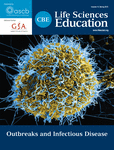Online Resources for Understanding Outbreaks and Infectious Diseases
Disease outbreaks are hot topics that often receive extensive national and international news coverage, although this coverage may not always be accurate. Engaging students with these current events can be a powerful way to teach about science and health. Accurate disease information is also an important public health issue, as misinformation can lead to fear and poor policy decisions. In this review, we highlight online resources for teaching about outbreaks and infectious diseases that will be useful for scientists and educators working with middle school, high school, and undergraduate students. We particularly focus on current news about infectious diseases, epidemiology, pathogen biology, and vaccines.
Infectious diseases are caused by pathogenic microbes, including viruses, bacteria, and parasites. Some diseases, such as the flu, spread from human to human, while others rely on a vector intermediate—for example, malaria is transmitted by mosquitoes. Outbreaks, or epidemics, are characterized by the rapid spread of disease in a population. An outbreak that becomes global is referred to as a pandemic. In 2009, the global spread of H1N1 “swine” flu was a pandemic, whereas the outbreak of Ebola that began in 2014 is an epidemic in West Africa, not a pandemic.
OUTBREAK NEWS AND INFORMATION
Several websites provide extensive information on infectious diseases and outbreaks. The World Health Organization (WHO) is an international public health agency within the United Nations and a global authority on disease outbreaks, epidemiology, and health. Its website (www.who.int) provides news and is a reliable source for the latest data on global health and disease. The Global Alert and Response (GAR) program is particularly relevant for infectious diseases (www.who.int/csr/en). Disease-specific data and information can be found in the Diseases section, located in the left menu. GAR also runs the Disease Outbreak News page (www.who.int/csr/don/en). These updates from around the globe include specific cases, public health response, risk assessment, and advice; updates may be sorted by year, disease, or country. The WHO website offers a wealth of information, but it can be somewhat difficult to navigate. Fortunately, current outbreaks are often linked directly from the home page, making navigation to outbreak information easier.
The Centers for Disease Control and Prevention (CDC) is the national public health agency of the United States. Its website (www.cdc.gov) maintains up-to-date information about disease and health both for the United States and abroad. The Outbreaks section of the CDC home page lists recent outbreaks and links to the CDC Current Outbreak List (www.cdc.gov/outbreaks/index.html). Outbreaks are sorted by location (U.S.-based and international) with links to information about each one. Information on specific diseases also can be found using the Diseases & Conditions pull-down menu on the CDC home page. Disease information is easy to navigate via a menu on the left side. This information often includes an overview, specific outbreaks, signs and symptoms, transmission, risks, prevention, diagnosis, treatments, healthcare worker information, travel considerations, and communication resources such as infographics, posters, fact sheets, audio clips, videos, maps, and brochures. Selecting a specific outbreak brings up additional information and resources. Content about current outbreaks is updated frequently, and the website is easy to navigate, despite containing a large amount of information and resources.
Bridging the gap between public health agencies and mainstream news media, the University of Minnesota’s Center for Infectious Disease Research and Policy (CIDRAP) website (www.cidrap.umn.edu) is an excellent source for the latest news about infectious diseases. Led by a team of public health professionals, CIDRAP combines expertise in research, policy, education, and news media. The CIDRAP home page is an easy-to-navigate online newspaper with original content on emerging diseases and outbreaks and is updated every weekday (Figure 1). Disease-specific content is accessed through the Infectious Disease Topics list in the top menu bar and includes more than 60 topics ranging from specific diseases such as norovirus to more general topics such as childhood vaccines and bioterrorism. These links provide easy access to detailed content and include menu tabs for Recent News, Resources, and Literature. The Literature tab includes a list of recent publications and time-stamped links to information and resources from national and international health agencies, professional organizations, and academic journals. In addition, many of the diseases, such as avian influenza and anthrax, have comprehensive overviews that synthesize information about each disease’s biology, epidemiology, clinical features, treatment, and current public health considerations and recommendations. The Public Health Practices section provides links to resources, including fact sheets, training materials, posters, and K–12 educational materials. The greatest strengths of this website are its ease of navigation, embedded links, lists of relevant research literature, and up-to-date content.
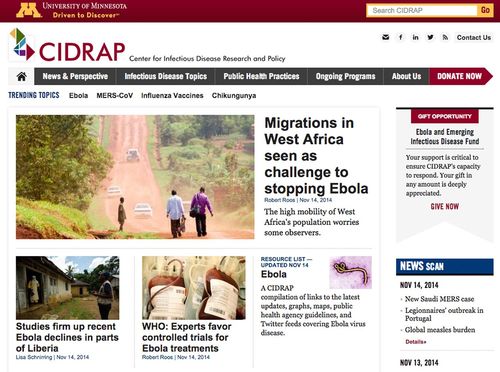
Figure 1. The CIDRAP home page (www.cidrap.umn.edu) features original news articles focusing on infectious disease and public health. The infectious disease topics link within the main navigation bar directs users to disease-specific news and resources.
EPIDEMIOLOGY AND DISEASE DETECTIVES
Epidemiology is the study of the incidence, spread, cause, and effect of disease in a population. The Marian Koshland Science Museum of the National Academy of Sciences has an online exhibit called Infectious Disease: Evolving Challenge to Human Health (www.koshland-science-museum .org/explore-the-science/interactives/infectious-disease#.VHOgilfF-K8). This virtual exhibit uses interactives to provide an introduction to epidemiology, disease biology, and pathogen evolution. The Virtual Field Trips section of the educator resources provides lessons using guided-inquiry approaches to exploring the online materials for middle and high school students. The middle school materials also include a classroom activity for simulating the spread of an infectious disease and tracing its source.
The cause of a disease is often mysterious. The CDC’s Solve the Outbreak game (Figure 2) allows the user to play the role of an epidemiologist, or disease detective, and is available online at www.cdc.gov/mobile/applications/sto/web-app.html and through the Apple and Android App stores. Users progress through story-based levels, answering questions in response to the clues and data provided. Although users are often given choices of what to do next, they will not advance in the game until they select the best answer. A How to Play tab is available, but most users will find the sleek interface intuitive. There is not much replay value once a case is solved, but a perfect score on the first 12 outbreaks in level 1 is required to access four new outbreaks in level 2. Throughout, the game provides links to relevant content on the CDC website, including details about real outbreaks. A Learn tab provides information on epidemiology and disease detectives, the Epi Curve tool, and careers in epidemiology and laboratory science. Badges are awarded for both game performance and accessing certain information.
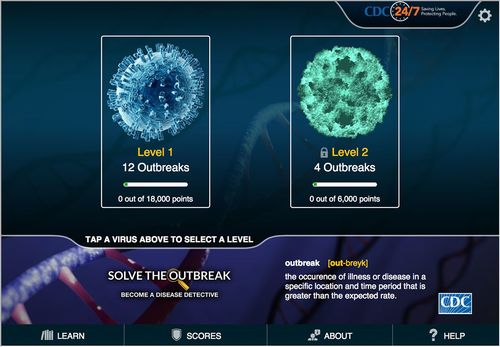
Figure 2. The CDC’s Solve the Outbreak game teaches about epidemiology and the spread of disease as users try to uncover the basis for different outbreak simulations (www.cdc.gov/mobile/applications/sto/web-app.html).
Rice University’s MedMyst (http://medmyst.rice.edu) also uses a disease detective game play to teach about the spread of disease. MedMyst is available in English and Spanish and is aimed at middle school students. The two most recent MedMyst Reloaded games are Disease Defenders and Animal Alert! (Figure 3). Both games engage users in investigating an infectious disease outbreak using science process skills and learning about the roles of epidemiologists, microbiologists, and veterinarians in an outbreak response. Game play is largely story line based and punctuated with more game-like activities, some of which are more closely tied to learning than others. A strength of MedMyst is that it portrays career possibilities in an inclusive and accessible way. The MedMyst educator site includes worksheets, classroom activities, and assessment items, and ties the games and materials to science standards.
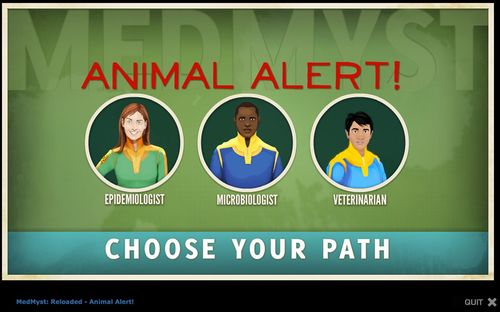
Figure 3. MedMyst’s Animal Alert! game allows users to chose a career path to investigate a disease outbreak (http://webadventures.rice.edu/ed/Teacher-Resources/_games/MedMyst -Reloaded/_402/Game-Overview.html).
PATHOGEN BIOLOGY
For delving into the biology of the pathogens themselves, a good starting point is the Microbe World website (www .microbeworld.org/index.php) produced by the American Society for Microbiology. The home page includes microbiology news and research updates, many of which focus on microbes that are not pathogens. Although some pathogenic microbes cause devastating diseases, it is important for students to learn that there are many more benign or beneficial microbes. Content on the website is largely text based with accompanying images or illustrations. The most recent videos and images can be found through tabs at the top of the site’s home page. To find information on a specific topic, use the keyword search in the top right corner; the search can be filtered by content type. Of particular relevance to infectious disease biology is a behind-the-scenes video (56:48 min) of researchers entering a biosafety level 4 laboratory where they must wear airtight suits to study the most dangerous infectious disease agents, such as the Ebola virus and the plague-causing bacteria Yersinia pestis (www.microbeworld .org/component/content/article?id=1362). Much of the information on the site is most appropriate for undergraduate students. At the bottom of the page, middle and high school students can find basic information about microbes and microbiology that would be appropriate for them.
VACCINES
Vaccination is a powerful means of combating infectious disease. There is significant interest in vaccines but also considerable misinformation about them. People are often curious about what vaccines are, how they work, and why we do not have a vaccine for every disease. Both WHO and the CDC provide some basic information about vaccines from the public health perspective at www.who.int/influenza/vaccines/en and www.cdc.gov/vaccines, respectively.
To provide engaging and accessible information about vaccine science and public health, the College of Physicians of Philadelphia has created an interactive website called The History of Vaccines (www.historyofvaccines.org). This website is easy to navigate, with tabs for timelines of vaccine history, activities, articles, and an image gallery. The Activities section contains interactives on how vaccines work, types of vaccines, and how vaccines are made. It also includes the Illsville game (Figure 4), which combines the history of medicine with concepts about epidemiology, quarantine, vaccination, and herd immunity. Players respond to disease outbreaks in a population by employing quarantine, doctors, and educators. The game ends with a vaccinated population that has achieved herd immunity. The Articles section of the website contains more details, including information on the challenges of vaccine design, why some diseases are difficult to target with vaccines, viral evolution, and optimistic news about vaccines against Ebola and HIV. The Educators link on the top right of the navigation bar links to the online activities and associated lesson plans. The website is available in English and Spanish.
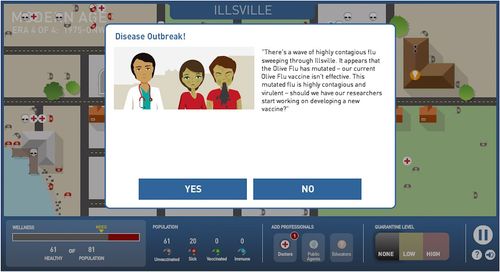
Figure 4. The History of Vaccine’s Illsville game teaches the history of medicine, explains how infectious diseases spread, and gives an overview of vaccines (www.historyofvaccines.org/content/illsville-fight-disease).
IMAGES
Images of pathogens and public health efforts will be useful for anyone doing outreach presentations. The CDC’s Public Health Image Library (http://phil.cdc.gov/phil/home .asp) is a searchable database containing health-related images, including photos of public health efforts and electron micrographs of microbes. The influenza section includes several three-dimensional graphical representations of a generic influenza virion’s ultrastructure. Clicking on an image provides a description and additional information. Graphics and images from the National Institute of Allergy and Infectious Disease (NIAID) include a striking image of an Ebola-infected cell (Figure 5). Many images can be found in their public Flickr account at www.flickr.com/photos/niaid.

Figure 5. Electron micrograph of a Vero E6 monkey cell (yellow) infected with Ebola virus (blue) from the NIAID (www.flickr.com/photos/niaid/14440817981).
ADDITIONAL RESOURCES FOR PRECOLLEGE TEACHERS
For middle and high school teachers, several epidemiology modules with detailed lesson plans are available online. The National Institutes of Health Curriculum Supplement Series on Emerging and Re-emerging Infectious Diseases tackles infectious diseases, epidemiology, public health, and policy at http://science.education.nih.gov/supplements/nih1/Diseases/default.htm. Published in 1999, these lessons include several online videos and contain five detailed activities targeted for the high school level. Montclair State University’s Detectives in the Classroom epidemiology curriculum (www.montclair.edu/Detectives/curriculum/CurriculumModules.htm) contains five modules aimed at middle and high school students; the six lessons in module 1 are relevant to infectious diseases. The CDC’s BAM! Body and Mind website (www.cdc.gov/bam) offers text and illustrations aimed at ages 9–13. It covers a variety of topics, including pathogens, the immune system, and vaccines. The corresponding teacher site (www.cdc.gov/bam/teachers/index.html) has an infectious disease epidemiology module with classroom lessons that introduce microbes, epidemiology, and the scientific process to younger students.
People are naturally curious about health and disease. Outbreaks and infectious diseases can be a powerful way to integrate current events, health, medicine, and science in the classroom. It is also beneficial to our communities when we share what we know to better inform students and policy makers. The websites reviewed here will make your task easier and can make a difference in the lives of students looking for careers that will be meaningful to them.
ACKNOWLEDGMENTS
We thank A. Malcolm Campbell for critical comments and helpful suggestions on this Feature.


